When choosing the perfect grill cleaning kit, you’ll need to match your grill’s material with compatible tools – stainless steel grates handle metal brushes well, while porcelain surfaces require non-metallic options to prevent damage. Look for bristle-free alternatives to avoid ingestion risks, ergonomic handles of 11-12 inches for safety, and heat-resistant materials. Consider your budget, cleaning frequency, and storage needs when selecting between basic $10 options for casual use or premium kits for frequent grilling. Understanding these factors will guide you toward ideal performance.
Understanding Different Types of Grill Cleaning Kits Available
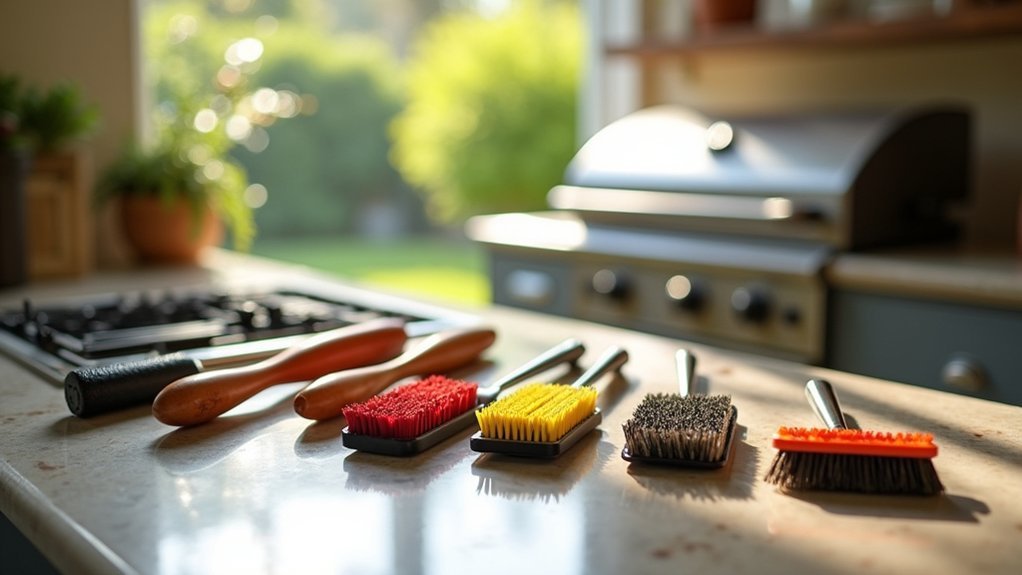
When you’re shopping for a grill cleaning kit, you’ll discover several distinct types designed to tackle different cleaning challenges.
Traditional kits feature wire brushes that effectively remove stubborn grime but raise safety concerns about bristle ingestion.
Safer alternatives include bristle-free brushes that use scraping mechanisms or nylon bristles to clean without metal fragments.
Steam cleaning kits utilize water-generated steam to loosen debris without harsh chemicals, making them environmentally friendly options.
Material-specific kits contain specialized tools for stainless steel, porcelain, or cast iron grills to prevent surface damage.
Modern grill cleaning kits emphasize ergonomic designs for comfortable handling and often include non-toxic cleaners that protect both your health and the environment while maintaining cleaning effectiveness.
Essential Tools Every Grill Cleaning Kit Should Include
Effectiveness in grill cleaning depends largely on having the right tools at your disposal. A durable grill cleaning brush with thick wire bristles forms the foundation of any quality kit, effectively scraping stubborn residue from grill grates.
However, you’ll also want wire-free alternatives like wooden scrapers that eliminate bristle-shedding risks while molding perfectly to grate surfaces.
Consider including a wet brush system that harnesses steam power for tackling tough grime more efficiently. For deep cleaning, you’ll need a high-quality degreaser specifically formulated for stainless steel surfaces to maintain your grill’s peak condition.
Don’t overlook simple accessories like aluminum foil balls, which provide quick scraping solutions for warm grates, making your cleaning process more efficient and less labor-intensive overall.
Choosing the Right Brush Type for Your Grill Surface
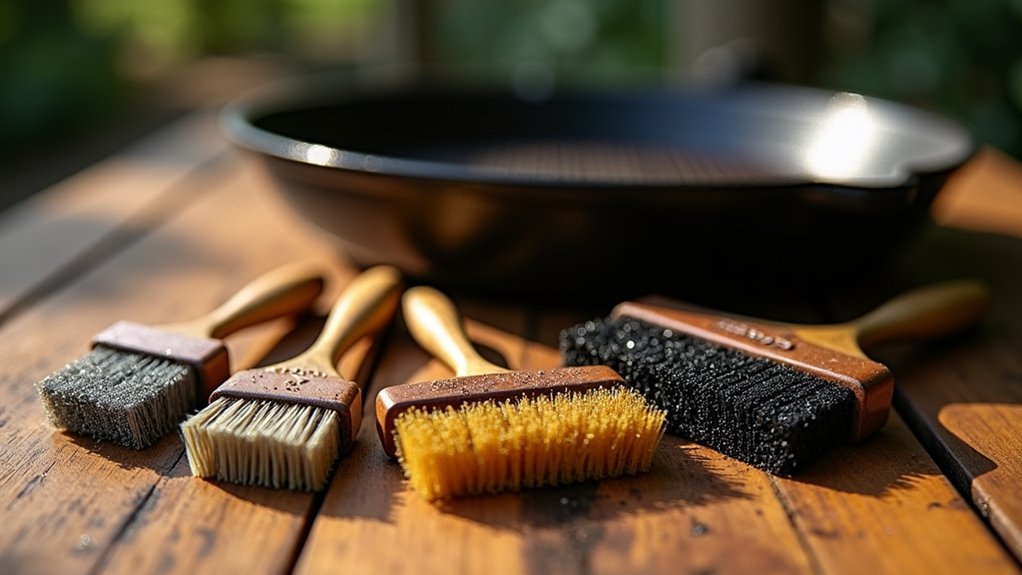
Since different grill surfaces require specific brush types to avoid damage, you’ll need to match your cleaning tool to your grate material.
For stainless steel grates, choose coiled or woven stainless steel brushes that effectively remove stubborn residue without harming the surface.
If you own porcelain grates, opt for non-metallic brushes with nylon bristles to prevent scratching or chipping the coating.
Pad-type brushes offer the safest cleaning option since they eliminate bristle shedding risks entirely.
When selecting any grill brush, verify the bristles are flexible and densely packed for peak performance on hot surfaces.
Always check your manufacturer’s recommendations, as not all cleaning tools work with every grate material.
Safety Considerations When Selecting Cleaning Tools
While selecting the right brush type matters for cleaning effectiveness, prioritizing safety considerations protects you from serious injuries during grill maintenance.
Choose bristle-free options to eliminate ingestion risks—loose bristles caused 1,700 emergency room visits from 2002-2014. Opt for non-metallic nylon brushes when cleaning hot grills, as they won’t shed dangerous metal pieces like traditional wire brushes.
Bristle-free grill brushes prevent dangerous ingestion risks that sent 1,700 people to emergency rooms over twelve years.
Select tools with heat-resistant materials and longer handles measuring 11-12 inches to keep your hands safely away from hot surfaces.
If your kit includes scraper blades, verify they’re short (quarter-inch) with side grooves for effective cleaning without injury risks.
Replace non-bristle tools after 25-100 uses and inspect all equipment regularly to maintain ideal safety and performance standards.
Handle Design and Ergonomics for Comfortable Use

When you’re selecting a grill brush, the handle’s design directly impacts your cleaning experience and safety.
You’ll want to evaluate the ideal length that keeps your hands safely away from heat while providing adequate reach and control.
The grip’s comfort features and angled design can make the difference between effortless cleaning and wrist strain during those thorough post-cookout sessions.
Handle Length Considerations
Although grill cleaning might seem like a straightforward task, the handle length of your cleaning tools directly impacts both your safety and cleaning effectiveness.
You’ll want to choose brushes with handles measuring 11 to 12 inches to maintain a safe distance from heat while providing adequate leverage. Longer 13-inch handles offer enhanced user comfort and superior control, especially when cleaning hot grills.
The ergonomic design becomes essential here – you’ll benefit from angled handles that facilitate proper pressure application during scrubbing. Avoid brushes with shorter 6.75-inch handles, as they’ll expose your hands to uncomfortable heat levels.
For ideal heat safety, prioritize tools with slip-resistant grips that prevent dangerous slippage during vigorous cleaning sessions.
Grip Comfort Features
Beyond maintaining proper distance from heat sources, the grip design of your cleaning tools determines how comfortably you’ll complete each cleaning session.
Among the grill brushes I tested, those featuring heat-resistant materials and slip-resistant molded grips consistently delivered superior grip comfort during extended use. These specialized grips prevent your hands from slipping, even when dealing with greasy surfaces or working in warm conditions.
Angled handles proved particularly valuable for reducing wrist strain while maintaining proper cleaning pressure.
Here’s what to look for in comfortable grip designs:
- Textured, non-slip surfaces that maintain their grip even when wet or greasy
- Ergonomic contours that naturally fit your hand’s shape and reduce pressure points
- Heat-resistant coating that stays cool and comfortable during extended cleaning sessions
Angled Handle Benefits
While ergonomic grips provide the foundation for comfortable cleaning, angled handles transform how effectively you’ll maneuver your brush across grill grates. This ergonomic design creates superior leverage, allowing you to apply pressure effortlessly while reducing wrist strain during extended cleaning sessions.
| Feature | Benefit |
|---|---|
| Angled Design | Enhanced pressure application |
| Extended Length | Heat protection and safety |
| Sloping Geometry | Better grate access |
| Improved Leverage | Reduced physical effort |
| Ergonomic Position | Minimized wrist fatigue |
The angled handle keeps your hands safely away from residual heat while maintaining peak control. You’ll notice improved cleaning efficiency as the sloping angle between head and handle lets you reach difficult spots with minimal effort. This thoughtful design greatly enhances user comfort, making thorough grill maintenance less physically demanding and more effective.
Durability Features That Ensure Long-Lasting Performance
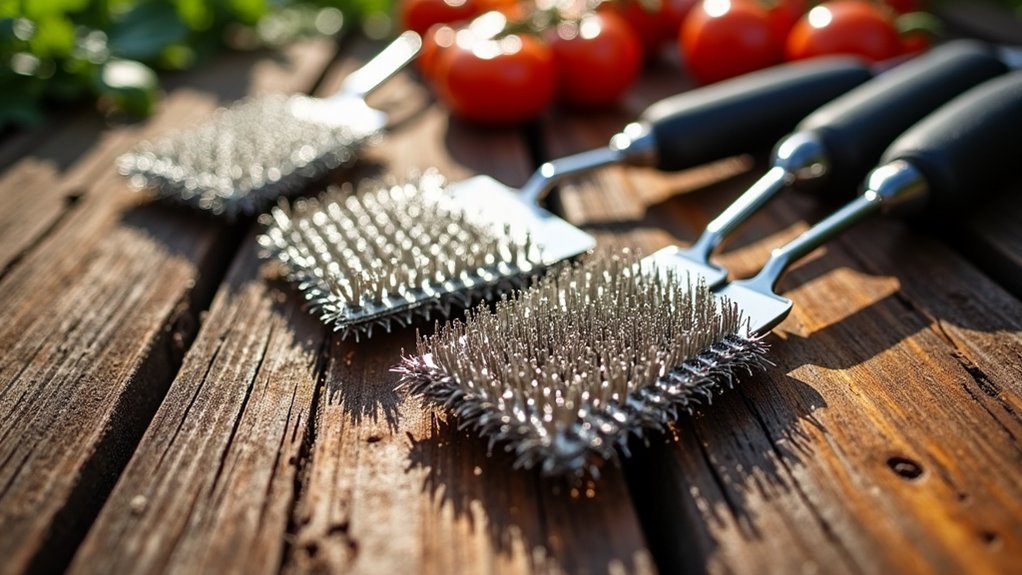
When you’re investing in a grill cleaning kit, you’ll want components that can withstand repeated use and harsh cleaning conditions. Look for brushes constructed with solid materials like stainless steel or high-quality nylon, as these enhance durability and reduce replacement frequency.
Wire bristles should be thick and densely packed to maintain their shape and cleaning effectiveness over time.
Consider kits featuring replaceable heads, like the OXO Good Grips Nylon Grill Brush, which extend your tool’s lifespan while maintaining efficiency. Slip-resistant, molded handles improve comfort and prevent accidental damage from drops.
Key durability indicators to examine:
- Dense wire bristle construction that resists bending and breaking
- Reinforced connection points between brush heads and handles
- Heat-resistant materials that won’t warp near hot grill surfaces
Regular inspection for wear guarantees continued safety and performance.
Hot Vs Cold Cleaning Methods and Tool Requirements
Although both hot and cold cleaning methods can effectively maintain your grill, understanding their distinct tool requirements will help you choose the right equipment for your preferred approach.
Hot cleaning methods offer superior efficiency since warm grates make burnt-on residue and grease removal easier. You’ll need brushes with coiled or woven stainless steel bristles that won’t shed when tackling heated surfaces.
Cold cleaning methods require more time and effort but offer safer handling. You should use nylon brushes specifically designed for cooled grates to prevent melting and damage.
Steam cleaning with water-soaked brush heads can effectively loosen grime, though you’ll need to take into account potential grill corrosion from moisture exposure when selecting this approach.
Scraper Designs and Their Effectiveness on Different Grates
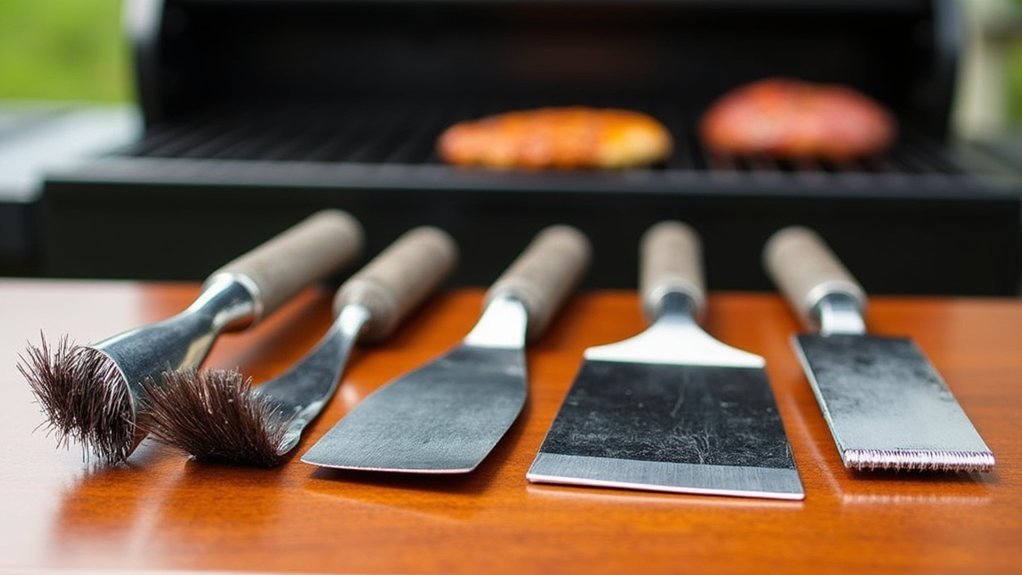
Since different grill grate materials demand specific scraping approaches, you’ll find that scraper design directly impacts your cleaning success.
Longer angled scrapers give you better leverage and reach tight spots that shorter designs can’t handle. Effective scraper blades should measure about a quarter inch with side grooves for enhanced cleaning across various surfaces.
Choose stainless steel scrapers for durability and power, but switch to non-metallic options for porcelain-coated grates to prevent damage.
The best scrapers combine flat surfaces with angled edges, letting you tackle both simple and intricate grill designs.
- Picture yourself effortlessly gliding the angled blade between narrow grill bars
- Visualize side grooves catching stubborn grease and debris as you scrape
- Imagine inspecting your blade for wear and tear after successful cleaning sessions
Material Compatibility for Various Grill Types
You’ll need different cleaning tools depending on your grill’s material composition to avoid costly damage.
Stainless steel grates can handle aggressive cleaning with metal brushes, while porcelain-coated surfaces require gentler, non-metallic options to prevent chipping.
Cast iron grates demand their own specific approach to maintain seasoning and prevent rust formation.
Stainless Steel Grates
When maintaining stainless steel grates, you’ll need cleaning tools that match their durability and resistance to corrosion.
These robust grates work excellently with gas and charcoal grills, but they demand specific care. Choose coiled or woven stainless steel brushes for your grill brush selection, as they’ll effectively tackle stubborn residue without scratching the surface.
Avoid non-metallic brushes on hot grates since they’ll melt, though they’re suitable once cooled.
- Steam rising from a hot grill brush gliding across gleaming steel bars
- Stubborn grease dissolving under gentle scrubbing motions with specialized tools
- Pristine grates reflecting flames after thorough seasonal deep cleaning
Regular maintenance prevents grease buildup and preserves performance.
Schedule thorough cleaning the grill sessions several times each season, using soft cleaning pads designed specifically for stainless steel to maintain their pristine condition.
Porcelain-Coated Surfaces
Porcelain-coated grates demand gentler treatment than their stainless steel counterparts, requiring non-metallic brushes that won’t compromise their protective coating.
When selecting a grill brush for porcelain-coated surfaces, you’ll need nylon or aramid fiber bristles instead of wire options. Wire brushes can chip and peel the coating, damaging your grill’s performance and longevity.
Choose cleaning tools specifically designed for porcelain surfaces to guarantee effective maintenance without harm. Look for brushes with soft bristles or pad-type designs that’ll remove grease and food residue while preserving the coating’s integrity.
Non-metallic grill brushes provide the gentle cleaning action these surfaces require.
Always check your manufacturer’s guidelines for recommended cleaning practices to maintain your warranty and keep your porcelain-coated grates in prime condition.
Cast Iron Compatibility
Cast iron grates present their own unique cleaning challenges that differ markedly from porcelain-coated surfaces.
You’ll need specialized cleaning methods to protect the precious seasoning that prevents rust and creates a natural non-stick surface. A bristle-free brush or wooden scraper works best, avoiding metal bristles that can scratch and damage your grates over time.
Your cleaning approach should focus on gentle techniques:
- Steam cleaning sessions – Let heat and moisture loosen stubborn grease without abrasive scraping
- Nylon brush scrubbing – Use soft, non-metallic bristles that won’t compromise the seasoning layer
- Natural degreaser application – Apply mild, chemical-free cleaners that preserve the protective coating
Choose a grill brush specifically designed for cast iron to maintain longevity and prevent surface deterioration.
Size and Portability Factors for Storage and Transport
Several key factors determine how easily you’ll store and transport your grill cleaning kit. Size matters greatly when selecting tools, as compact and lightweight options excel in both storage and portability.
You’ll appreciate foldable or detachable components that dramatically reduce your kit’s footprint, especially during camping trips or outdoor events.
Consider investing in kits featuring carrying cases or organizers. These protect your tools while preventing lost components during transport.
Multi-functional tools offer exceptional value by combining multiple capabilities into single items. A grill brush with built-in scraper exemplifies this approach, reducing the total items you’ll carry.
Weight plays an important role in your decision. Lighter kits prove easier to handle and transport, making them ideal if you frequently travel or face storage limitations in your home.
Budget Considerations and Value-to-Performance Ratios
Finding the right balance between cost and performance requires careful evaluation of what each grill cleaning kit offers for its price point.
Smart grill cleaning purchases balance upfront costs with long-term performance to maximize value for your specific grilling habits.
Budget-friendly options like the Cuisinart Grill Cleaning Brush deliver essential features including a long handle and scraper at lower costs.
Mid-range choices such as the GRILLART Grill Brush at $21 provide an excellent value-to-performance ratio for most grillers.
While premium kits like the Williams Sonoma brush cost $40, they offer superior durable cleaning performance through quality materials.
Consider these price-performance scenarios:
- Casual grillers can achieve effective results with $10 cleaners like Goo Gone
- Weekend enthusiasts benefit from $20-25 brushes offering balanced features
- Frequent grillers should invest in premium options to avoid constant replacements
Maintenance Requirements for Your Cleaning Kit Tools
While investing in quality grill cleaning tools represents just the first step, you’ll need to maintain them properly to maximize their lifespan and cleaning effectiveness.
Replace your grill brush every 25-100 uses to prevent loose bristles from creating safety hazards when you clean your grill. After each use, soak brushes in soapy water or run dishwasher-safe models through your dishwasher for proper maintenance.
Store your cleaning tools in a dry, cool location to prevent rust and material degradation. Replace scraper blades when they become dull, choosing short, grooved designs for peak performance.
For tools with replaceable heads, keep spare nylon brush heads available to guarantee consistent cleaning capability throughout the grilling season.
Frequently Asked Questions
What Is the Best Thing to Use to Clean Your Grill?
You’ll want a durable wire brush for regular cleaning and a wooden scraper like Kona Safe/Clean for safety. For deep cleaning, mix baking soda with dish soap to tackle stubborn grease effectively.
What Is the Best Kind of Grill Brush to Use?
You’ll want a bristle-free grill brush or one with coiled stainless steel bristles and an 11-12 inch handle. These eliminate safety risks from loose bristles while providing effective cleaning power and keeping your hands away from heat.
Is Professional Grill Cleaning Worth It?
Yes, professional grill cleaning’s worth it if you frequently grill or lack time for deep maintenance. You’ll extend your grill’s lifespan, catch potential issues early, and guarantee thorough sanitization that regular cleaning can’t achieve.
What Not to Clean Your Grill With?
Don’t use metal scrapers, wire brushes, steel wool, harsh chemicals, abrasive cleaners, or household products containing ammonia or bleach. These can damage your grill’s surface and create serious health hazards.

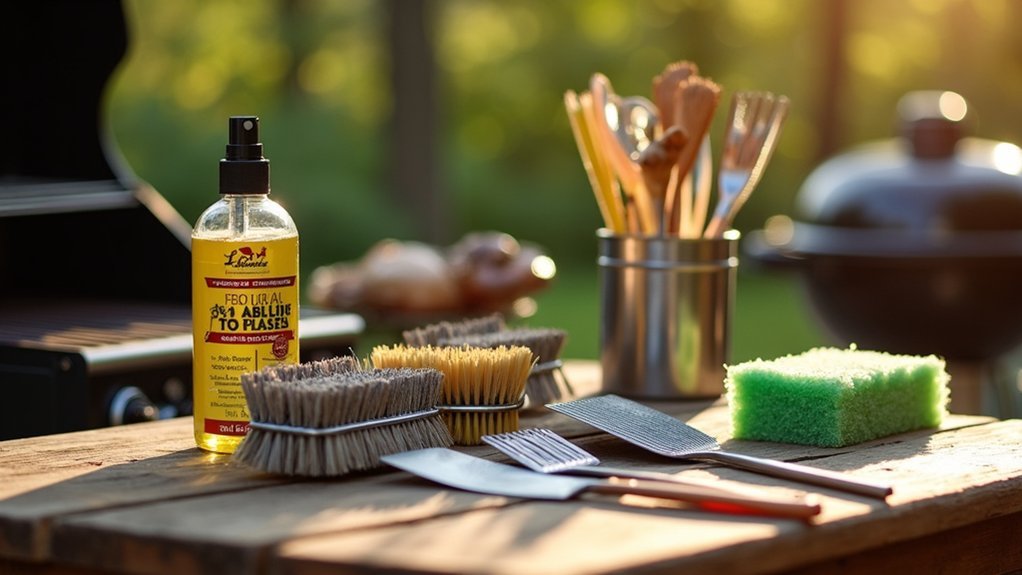



Leave a Reply